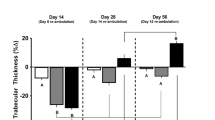Abstract
Hindlimb suspension is a well-established rodent model of disuse-induced atrophy and is commonly used to simulate the effects of bed rest and space flight on humans. Over the decades, this method has undergone many changes to reduce the stress response on the animals and improve the reliability of the data. Here, we detail our method of performing hindlimb suspension in mice that minimizes stress, maximizes the replicability of the data, and uses space efficiently.
Access this chapter
Tax calculation will be finalised at checkout
Purchases are for personal use only
Similar content being viewed by others
References
Templeton GH, Silver CJ, Leconey T, Silver P, Hagler H, DeMartino G et al (1984) Influence of suspension hypokinesia on rat soleus muscle. J Appl Physiol 56(2):278–286
Morey ER (1979) Spaceflight and bone turnover: correlation with a new rat model of weightlessness. Bioscience. 29(3):168–172
Steffen JM, Robb R, Dombrowski MJ, Musacchia XJ, Mandel AD, Sonnenfeld G (1984) A suspension model for hypokinetic/hypodynamic and antiorthostatic responses in the mouse. Aviat Space Environ Med 55(7):612–616
Templeton GH, Padalino M, Manton J, LeConey T, Hagler H, Glasberg M (1984) The influence of rat suspension-hypokinesia on the gastrocnemius muscle. Aviat Space Environ Med 55(5):381–386
Ohira T, Kawano F, Ohira T, Goto K, Ohira Y (2015) Responses of skeletal muscles to gravitational unloading and/or reloading. J Physiol Sci 65(4):293–310
Globus RK, Morey-Holton E (2016) Hindlimb unloading: rodent analog for microgravity. J Appl Physiol (1985) 120(10):1196–1206
Morey-Holton ER, Globus RK (2002) Hindlimb unloading rodent model: technical aspects. J Appl Physiol (1985) 92(4):1367–1377
Qualls AE, Southern WM, Call JA (2021) Mitochondria-cytokine crosstalk following skeletal muscle injury and disuse: a mini-review. Am J Physiol Cell Physiol. 320(5):C681–C688
Yoshihara T, Naito H (2020) Protective effects of acute exercise preconditioning on disuse-induced muscular atrophy in aged muscle: a narrative literature review. J Physiolog Sci. 70(1):55
Yakabe M, Ogawa S, Ota H, Iijima K, Eto M, Ouchi Y et al (2018) Inhibition of interleukin-6 decreases atrogene expression and ameliorates tail suspension-induced skeletal muscle atrophy. PLoS One 13(1):e0191318
Grano M, Mori G, Minielli V, Barou O, Colucci S, Giannelli G et al (2002) Rat hindlimb unloading by tail suspension reduces osteoblast differentiation, induces IL-6 secretion, and increases bone resorption in ex vivo cultures. Calcif Tissue Int 70(3):176–185
Zhang P, Li W, Liu H, Li J, Wang J, Li Y et al (2014) Dystrophin involved in the susceptibility of slow muscles to hindlimb unloading via concomitant activation of TGF-β1/Smad3 signaling and ubiquitin–proteasome degradation in mice. Cell Biochem Biophys. 70(2):1057–1067
Allen RE, Boxhorn LK (1987) Inhibition of skeletal muscle satellite cell differentiation by transforming growth factor-beta. J Cell Physiol 133(3):567–572
Allen RE, Boxhorn LK (1989) Regulation of skeletal muscle satellite cell proliferation and differentiation by transforming growth factor-beta, insulin-like growth factor I, and fibroblast growth factor. J Cell Physiol 138(2):311–315
Wang Y, Pessin J (2013) Mechanisms for fiber-type specificity of skeletal muscle atrophy. Curr Opin Clin Nutr Metab Care 16(3):243–250
Wang J, Wang X, Feng W (2017) Reloading promotes recovery of disuse muscle loss by inhibiting TGFβ pathway activation in rats after hind limb suspension. Am J Phys Med Rehabil 96(6):430–437
Marzuca-Nassr GN, Vitzel KF, Murata GM, Márquez JL, Curi R (2018) Experimental model of HindLimb suspension-induced skeletal muscle atrophy in rodents. In: Pre-Clinical Models. Springer New York, New York, NY, pp 167–176
Ferreira JA, Crissey JM, Brown M (2011) An alternant method to the traditional NASA Hindlimb unloading model in mice. J Vis Exp 49:2467
Acknowledgments
This study was supported by grants from National Institutes of Health to HZ (HL153876 and AR067766).
Author information
Authors and Affiliations
Corresponding author
Editor information
Editors and Affiliations
Rights and permissions
Copyright information
© 2023 The Author(s), under exclusive license to Springer Science+Business Media, LLC, part of Springer Nature
About this protocol
Cite this protocol
Kutz, L., Zhou, T., Chen, Q., Zhu, H. (2023). A Surgical Approach to Hindlimb Suspension: A Mouse Model of Disuse-Induced Atrophy. In: Lucas, A.R. (eds) Chemokine-Glycosaminoglycan Interactions. Methods in Molecular Biology, vol 2597. Humana, New York, NY. https://doi.org/10.1007/978-1-0716-2835-5_1
Download citation
DOI: https://doi.org/10.1007/978-1-0716-2835-5_1
Published:
Publisher Name: Humana, New York, NY
Print ISBN: 978-1-0716-2834-8
Online ISBN: 978-1-0716-2835-5
eBook Packages: Springer Protocols




